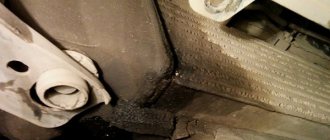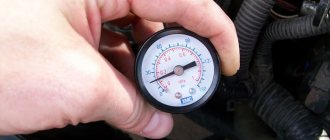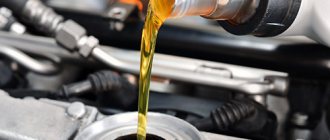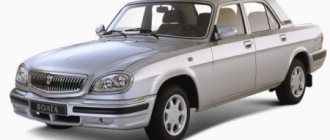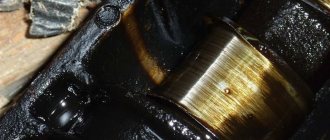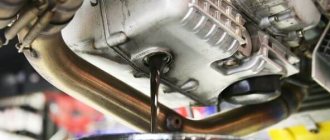It eats oil and... smokes!
So, to put an end to the double understanding of the title of the section, we suggest reading our previous material. Let us remember that there we were talking about how to determine why oil is being consumed: rings or caps.
The fact is that with leaking valve stem seals, the engine consumes oil, but does not smoke... in civilian operating modes. We have described in detail why blue smoke from worn valve seals is visible only when a number of conditions are met.
So before you make a smoke-free claim, consider two facts:
- Take into account the method for diagnosing caps outlined in the previous material and once again make sure that the exhaust does not smoke.
- Find out if the brand of oil you are using is prone to burning. We recommend reading the reviews. For example, on Drive2.ru, every second Castrol customer complains about high oil emulsion consumption even on a new engine. It is noteworthy that they are united by a common solution to the problem: when switching to a lubricant from another manufacturer, the zhor disappears.
Active driving and oil quality
All car owners who like to test it in aggressive mode may encounter the problem of increased oil consumption. Engine operation at high speeds requires greater oil consumption. As a result of such driving, the driver will have to change the oil 3-4 times faster than when operating the car in normal mode.
It is important to remember that the quality of the mixture used depends on the type of driving you prefer.
If the car's mileage is low, then 5W30 or 0W20 class oil should be used. This choice is due to the fact that new engines do not wear out and therefore the bearings operate on fluid with a low viscosity level.
If the car's mileage exceeds 50,000 km, then it is necessary to use 5W40 class oil. This depends on the degree of wear of the engine; with more wear, the percentage of viscosity when choosing an oil increases.
The engine eats engine oil, but does not smoke: what is the reason
If there really is no smoke, then the conclusion suggests itself - the lubricant does not burn out, but goes away. There are plenty of joints in the engine from which fluid under pressure can leak. This can be as small as a loose drain plug, or something more serious - for example, a sweaty valve cover. It is also possible that there is a leak, but there are no traces of it outside.
To make diagnosis easier, let’s divide all the symptoms into two groups:
- Clear leakage. When inspecting the engine compartment or area under the car, clear oily stains are found.
- Implicit leak. There are no external signs, it becomes noticeable only after dismantling a number of parts.
The leak location is clearly visible
The conclusion that there is a leak somewhere is usually made based on an inspection of a long-term parking area. Confirmation of this is oil traces under the engine. To make it more convincing, you can put a sheet of white cardboard. This will help determine the color of the liquid, and therefore find out which system has a problem. For example, a red or green spot indicates that the hydraulic booster (power steering) is leaking.
Obvious leak points include the following connections:
- Cylinder head valve cover. To seal this joint, either rubber gaskets or sealant are used. The connection is quite capricious. For example, the cuff must be changed after each disassembly, and the sealant rarely lasts longer than 5 years.
- Cylinder block-sump. There is a rubber gasket installed here.
- Engine oil filter housing. A year earlier, we looked at why oil squeezes out from under the air filter on various engines. As a short summary, we present the following fact: oil can leak from this joint under the pretext of one of 7 reasons.
- Oil pressure sensor. Clamp the part and the leak will go away.
There are no traces of lubrication, but the oil is leaving
The situation is such that the engine compartment is clean, there are no stains under the car, and the dipstick clearly shows the sagging level of lubricant. The list of diagnostic actions in this situation is as follows:
- Look into the spark plug wells. For example, oil in the spark plug well of Lada Priora and Lada Granta with 16-valve engines leads to serious consequences. So, the ignition coil ends up in liquid and fails. This also threatens foreign cars, since there is no fundamental difference between “injectors” with 4 valves per cylinder.
- Remove the timing belt cover. Pay attention to the crankshaft and camshaft seals. Even a slightly sweaty rubber band needs to be changed.
For your information. A rubber-fabric timing belt is prone to rupture when exposed to oil.
Increased engine oil consumption: causes and solutions
A driver who does not regularly monitor the good condition of the various mechanisms of the car puts not only its normal operation in great danger, but also his life. But, perhaps, the main question of the proper functioning of a car is where does the oil go from the engine? We'll dive into why this is important and what could be causing this problem.
When to sound the alarm
There are no exact norms for oil consumption, as is the case with fuel. Older car models use more oil than modern internal combustion engines. If in the first case this indicator is critical - half a liter per 1000 km, then for modernized cars this norm can be 1 liter about 10 thousand km.
But, again, this is not the ultimate truth. There are other factors that we will consider below. But the main criterion is a sharp and constant drop in the oil level over several days.
But in order to “sound the alarm”, it is necessary to notice this problem. This is the main prevention of accidents. Auto mechanics advise checking the oil level before each trip. This is a truism. The level is checked on a cold engine (during movement, the oil warms up and increases in volume). And as a result, you will not get an accurate indicator.
At the same time, if you notice a decrease in the level, it is not enough to simply add lubricant; it is advisable to try to understand why the oil in the engine is leaking. In the article you will receive tips on how to make the correct “diagnosis”.
Oil consumption according to technical specifications
It is well known that any liquid tends to evaporate. Faster or slower, that's a different question. This process is accelerated at high temperatures, which are typical for engine operation. During normal engine operation, oil consumption should be minimal. At the same time, different brands and models of cars can consume different amounts of it. If you don’t have to constantly carry a can of oil and add it not every day, but once a week, there’s no need to worry.
Oil quality
Oil consumption largely depends on its viscosity and quality. If with viscosity everything is more or less clear, the thinner the oil, the more it flows through various seals, then with quality it is a little more complicated. The fact is that most car owners prefer to buy motor oil for their engine for “cheaper” reasons.
For example, open the filler neck on your engine's valve cover. What do you see inside? That's right, black soot. Where does the soot come from? Yes, from oil. If the temperature is too high, cheap motor oil breaks down and deposits on the walls. Oil loss occurs and its level in the engine crankcase decreases. This, in turn, among other negative consequences, leads to a decrease in the oil level in the engine, which again does not have the best effect on its ability to cool in the oil pan. This means that in the future there will be even greater overheating of the engine oil. Unfortunately, the durability of an engine with such (cheap) motor oil is expected to be very low.
So, the first disadvantage of bad oil is that it is destroyed by high temperature and actually ceases to be oil. The high-quality product that manufacturers recommend.
The second disadvantage of low-grade oils is that, when they break down, they pollute the engine with their decay products (carbon deposits). As a result, due to this carbon deposits, the piston rings barely move in their grooves, but must “play”, continuously tracking the, alas, no longer ideal, cylinder profile. The result is the occurrence (coking) of the piston rings. And, as follows from practice, the oil scraper rings will stop moving first. As a result, unremoved oil will remain on the cylinder walls, which will burn. A car with a gasoline engine will smoke bluish smoke. Diesel - no. All remaining oil in a diesel engine will burn without any smoke. The most curious thing is that if you measure the compression with this defect (the occurrence of oil scraper rings), the results will be excellent. The oil not removed from the cylinder walls will seal the gaps in the compression rings, and the pressure gauge will show the pressure even better than that of a new engine.
And the third thing that the use of low-grade oils will lead to is the destruction of all “rubber bands”. After overheating, the rubber of all oil seals, seals, and valve stem seals will lose its elasticity and turn into some kind of plastic. Naturally, after this an oil leak will appear. And all these problems arise from the desire to win something by servicing your iron friend by buying him cheaper oil.
Let's look at other reasons that cause a decrease in the oil level in the engine. The most common is a banal leak. Some problems can be fixed on your own, but others cannot be dealt with without a good specialist. First, let's look at what you can do yourself. If we talk about leaks, you should pay attention to the engine seals. Details below.
“Simple” reasons for oil consumption
It's easy to check. Remove the valve cover and take a look. If everything underneath is black, with thick deposits of fuel oil on all parts, then oil consumption is largely caused by oil waste. Second option. If, a week after changing the oil, it became black again (we are not talking about diesel engines, where the blackening of the engine oil does not mean anything), then one of two things: either the engine is terribly dirty and the new oil successfully dissolves this dirt in itself, or the new oil is rapidly destroyed and, naturally, decreases, becoming increasingly contaminated with the products of its waste. By the way, this is a very common reason for engine failure.
Oil may leak through the cylinder block gasket. This situation occurs if the power bolts are unevenly tightened during engine assembly. As a result, the gasket may become deformed and not ensure a tight fit of the parts. Clear evidence of this problem will be drips on the engine, which are easy to identify visually. Just look under the hood and the problem is obvious. In this case, it is important to take into account that low oil levels are part of the problem. Much more serious is the possibility in this case of antifreeze getting inside the cylinders. Here you can already “lose” the engine. Therefore, it is necessary not only to replace the gasket, but also to make sure that no coolant gets into the cylinders. There is doubt about the opposite - you need to change the oil completely.
Crankshaft oil seals are another “passage” for leaking oil. It is not difficult to determine a leak by looking at the seals. If an oil puddle has formed under the car while parked, then there is a high probability that the edges of the oil seals, intended for sealing, have become unusable (frayed, worn out). This is a fairly common problem because rubber itself is short-lived. One of the reasons may also be exposure to low-quality oil. Therefore, it is necessary to purchase only modern oil seals, adapted for operation in extreme conditions. Solving this problem is not difficult; it is enough to replace the worn oil seals with new ones and the question of where the oil goes from the engine will disappear on its own.
Oil may escape through the oil filter gaskets. This unpleasant situation occurs as a result of hasty or inept filter replacement. To make it more clear: the filter was either not tightened, which eliminates the tightness, or the gasket was wrinkled and the result is the same. In the first case, you need to tighten the filter more tightly. In the second - see if the gasket is in good condition, if not, replace it, but be sure to lubricate it with machine oil. This guarantees its elasticity, on the one hand, and uniformity of fit, on the other.
Oil seals (they are oil seals, they are also valve seals). These parts are located at the top of the cylinder head. And as a result, they are exposed to particularly high temperatures. Considering that they are made of rubber (even if it is highly durable and heat-resistant), it is rubber and will not be able to withstand critical temperatures for long. The properties of the caps begin to resemble plastic more and do not perform their functions. As a result, the oil begins to leak out, covering the exhaust valves with organic deposits. Another leak option is a defective cap, the effect is the same. In this case, only replacing the caps will help. For those who like fast starts, a special warning - constant extreme driving can “rip” it from its place (if it was not installed correctly).
“Complex” reasons for oil consumption
A much more unpleasant and difficult to eliminate cause of low oil level is coking of the piston rings. Piston rings perform their functions well only when clean. Thanks to this they have excellent mobility. If they coke and sink, there can be no question of any compaction. In this case, a decrease in compression of one or more cylinders is noticed. It is impossible not to notice this from the engine's operation. There are several reasons for this phenomenon: low-quality and “old” oil. In this case, you can try to do without major repairs. There are special products (chemicals that can dissolve plaque) that need to be used to treat the rings. And of course, a complete oil change will be required.
High cylinder wear has a greater impact on oil consumption than the previously discussed piston ring problems. Boring can solve the problem in some cases. But there are also “hidden” integrity violations up to a certain point - these are microcracks, small chips. They are figuratively “filled” with oil and this leads to a slight, but daily decrease in the level, which becomes clearly noticeable after a week and even more so a month.
Another rather specific problem associated with the design features of cylinders is their deformation. When installing anchor studs, peculiar distortions occur that affect the installation and operation of the O-rings. In fact, the latter cannot provide a sufficiently tight fit due to the “crescent-shaped gaps”. Using relatively soft rings can help out. But again, you will “eat” more oil.
Oil scraper piston rings. These engine elements are designed to ensure that the required amount of oil reaches the compression rings. And as a result, they do not have constant lubrication, that is, they do not “bathe” in oil, like some parts. In this case, friction increases and wear occurs faster. There is no metal that can last forever. This also applies to these car parts. High oil consumption indicates that the piston rings have worn down significantly. Do not try to solve this problem yourself. Here, without a service station, you can only “break wood.”
Oil can also escape through the piston rings. This problem occurs as a result of overheating. There are critical temperatures at which piston rings retain their elasticity well and perfectly perform their functions. This range is defined as 180 to 200 degrees. A small “plus” is allowed, since all parts are created with an additional margin of safety. But at the same time, even a one-time significant increase in the operating temperature of the engine can lead to a decrease in the functions of the piston rings, and as a result, an increase in oil consumption. A good motor mechanic, service station, car service will help. In general, you should not self-medicate.
Intervalve jumpers. This is one of the so-called thermal fatigue defects. In this case, in addition to the wear of the pistons, the combustion chamber is damaged; it loses the necessary seal. As in the previous case, contact only specialists.
Specific reasons?
We would like to note several points not related to the design features of the car. And more importantly, you can influence them without having the knowledge of a car mechanic.
Extreme riding. Fans of fast starts, sharp braking, driving at the limit of the car in general and the engine in particular should be aware that this cannot but affect the engine. The pistons work under heavy loads, the temperature rises, you can remember and review the previous subheadings and descriptions of the problems associated with this. Therefore, there are two options for solving this issue. Travel in normal mode, provided for by the operating characteristics of the machine. Or an additional can of oil in the trunk and a certain amount of money for repairs.
Late combustion causes increased oil consumption. This is due to the fact that the engine temperature rises with all the ensuing consequences. In this case, it is necessary to adjust the ignition and use high-quality fuel with an octane rating that matches the model of your car.
Turbocharger lubrication. These are, in principle, natural losses that are difficult to influence. But as a rule, such consumption is associated with expensive foreign cars with a turbo engine.
Poor quality oil. The higher the viscosity, the better the lubricant. Everything seems to be clear with this. But at the same time it creates additional waste in the pistons. And this is where the fork comes in: to increase engine life or oil consumption. It is an indisputable fact that it is necessary to buy licensed oil from well-known manufacturers and at least somehow protect yourself.
Is there an oil consumption rate? There is no exact figure as such. But if a month ago you did not have such a problem, and now it is becoming quite obvious, then the problem is not in the design features of the car.
At the same time, a sufficient amount of oil will avoid serious engine damage. We have looked at the reasons that allow you to understand where the oil goes from the engine, this will help you monitor proper operation and avoid serious expenses for repair work.
Features of the problem
This problem can be divided into two types:
- increased consumption, at which the car smokes heavily;
- increased consumption at which the car does not smoke.
These are two completely different faults that are in no way related to each other. This article will bring some clarity to why the engine consumes oil. If with heavy smoke everything is more or less clear - it simply enters the combustion chamber and flies out into the exhaust pipe, then in the other version there is no such clarity.
But if you approach the question of why such a large flow rate appeared, logically, it will become clear that the reason for everything is an ordinary leak. This may explain why the engine began to consume a lot of motor oil.
It can leak in different ways, some places can be easily checked and traces can be found, and some cannot be easily found. What to do and how to detect oil leakage? It is enough to pay attention to the ground where the vehicle is parked, where an oil puddle will remain.
Places through which engine oil leaks are divided into two types:
- explicit;
- hidden.
Engine oil consumption rate for waste
For passenger vehicles, the normal burn rate is 0.005 - 0.025% per 100 liters of fuel, which is approximately 5 to 25 grams of oil per 1 thousand km. In a worn engine it can reach up to 0.1% and 100 g. per 1000 km respectively. Well, if the car operates at the limit or has a turbocharged or diesel unit, then this norm will be even higher.
For long cargo trucks, the oil consumption rate is 0.3 - 0.4% of fuel consumption. The calculation formula uses the amount of fuel burned and oil added during this period. But this calculation of oil consumption, proposed by the automaker Scania, is relevant only for heavy cars with a large engine. Calculations of lubricant consumption in passenger cars, both with diesel and gasoline engines, have a slightly different form.
Engine oil consumption rate per 100 liters. fuel for passenger cars
| engine's type | Acceptable waste | |||
| In percent, % 100 l. fuel | In grams, g per 1000 km | |||
| New | Worn out | New | Worn out | |
| Petrol | 0,005 – 0,025 | 0,025 – 0,1 | 5 to 25 | 25 – 100 |
| Turbocharged | 0,05 – 0,08 | 0,5 – 1 | up to 100 | 100 – 300 |
| Diesel | 0,035 – 0,25 | 0,3 – 0,8 | 30 – 55 | up to 200 |
| Rotary | 0,5 – 1,2 | 1 – 2 | 500 – 1000 | up to 2000 |
A gasoline engine operating at the limit of its capabilities can consume from 0.4 to 0.6% at 100 hp. fuel consumed, which is approximately 400 - 600 grams of engine oil per 1000 km. The situation is exactly the same with diesel engines - engine lubricant consumption increases by 0.5%. But if these are forced turbodiesels with two turbines, then the consumption can reach up to 3% of the volume of oil poured into the engine.
Keep in mind that oil consumption rates increase significantly for cars after major repairs and in operation for more than five years .
Method for determining oil consumption
Oil level on dipstick
Determination of the actual value of specific engine oil consumption for waste is carried out over a mileage of 200-300 km. The vehicle must be technically sound during the test drive. The oil level in the crankcase should be between the “MAX” and “MIN” marks on the engine dipstick. Before the test run, it is necessary to warm up the engine, the oil temperature should be 80-85°C. Drain the oil on a level surface. It should drain from the pan within 15 minutes. For the accuracy of the result, it is advisable to determine not the volume, but rather the weight, since the amount of lubricant remaining in the filter can only be determined by weighing it.
Explicit places
Finding obvious places is quite simple; to do this, you need to wash the crankcase of the power unit, drive the car onto a lift or inspection hole and visually inspect the oil traces. Let's look at the most likely leak locations.
Valve cover gasket
It has a fairly large area and loses its elasticity over time. Traces can be found without any problems, you just need to carefully examine it. It may well begin to leak through it. The malfunction is eliminated by replacing the old seal with a new one. After replacement, the engine will no longer consume a lot of oil.
Camshaft seals
They have increased wear due to the speed of the camshafts. Thus, they develop a sealing surface and lose the tightness of the connection. Characteristic marks are also revealed by careful inspection. Because of this, the engine eats a lot of lubricating fluid. The problem is solved by replacing old seals with new ones.
Front and rear crankshaft oil seals
They are also subject to increased load and lose their tightness over time. You can check them by simply inspecting the front and rear parts of the crankcase of the power unit, on which oil traces will be clearly visible. This may create the feeling that the car is eating a lot of lubricant. The malfunction is eliminated by replacing with new ones, but in order to change the rear oil seal, you will have to do a fairly large amount of work to remove the gearbox.
Engine oil pan gasket
It is one of the largest in terms of seal area and is subject to constant oil presence. Over time, it loses its sealing properties, which contributes to possible leakage. The problem is discovered by inspection. If you replace the gasket with a new one, the problem will disappear.
Front engine cover gasket
The part also loses its properties over time, and oil can leak through it. Here it’s worth looking more closely; often oil traces spread along the edges of the pan, and it seems that it is the pan that is leaking.
Filler cap
Through its rubber seal it can release lubricating fluid under pressure. The leak is fixed by installing a new filler cap.
All places of leakage are quite capable of creating among inexperienced drivers the opinion that the power unit has begun to eat a lot of oil and does not smoke. They should pay special attention to the presence of the required level of lubricating fluid and check the car components for leaks.
How to use the calculator
One of the main roles in this calculation is played by the volume of fuel burned and the volume of operating oil, as well as the type of engine. It is in relation to this volume and specifics of work that the specific oil consumption is calculated.
To calculate specific engine oil consumption, the following data is required:
- In the “fuel” field, enter the average fuel consumption in liters per 1`000 km. mileage (by default and based on calculation formulas this is 100 liters);
- In the “oil” field - the volume of oil that is regulated by the manufacturer as necessary when filling;
- Select the engine type and check if the machine has been in use for more than 5 years
- Click "calculate".
Such a calculation calculator can be an indispensable assistant for calculating the consumption rate of lubricants intended for operational accounting of the specific consumption of motor oil when justifying the need for them. After all, if not all, then many car enthusiasts have a rather wary attitude towards engine oil consumption. This service will show whether you are within the nominal values. If not, then you will have an objective reason to look for reasons and possible problems.
What's the outcome
That is, if the engine is in order, then it takes practically no oil, and you will not need to top it up until the next change. Its level will be within acceptable limits on the dipstick (within the min./max. marks). But there are cases when the manufacturer indicates consumption rates for a specific power unit (some engines eat oil), then topping it up is considered natural and is not a malfunction, but on average it does not exceed 1-2 glasses from replacement to replacement.
It is important to understand that the harder the engine runs, the more oil it burns. For example, the higher the number of revolutions, the more oil will remain in the cylinders of the car engine. Although we should not forget not only about the operating mode of the engine, but also its design. You should also not neglect the tolerances of motor oils and fill in fuels and lubricants of dubious quality.
It will be useful: Chevrolet Cruze EGR: how to replace
Subscribe
to our channel in
Index.Zen
Even more useful tips in a convenient format
Hidden places
Hidden places imply a leak that is not visible during simple inspection. To identify them, pay attention to other signs. Such options can confuse inexperienced car owners who are unable to understand why the engine eats a lot, does not smoke, and begins the wrong search for solutions. What needs to be done and how to check hidden places.
Cylinder head gasket
The main channel for lubrication of cylinder head parts passes through it. Breaking the gasket seal in this place will allow lubricant to enter the cooling system.
An inexperienced driver cannot detect such a malfunction. Not finding external traces of oil, he does not pay attention to the fact that the car eats a lot of motor lubricant and stops searching, thereby smoothly leading the power unit to failure and subsequent major repairs.
Crankcase ventilation
It plays a very important role in the correct operation of the motor.
When the ventilation is clogged, engine lubricant is released into the intake manifold or into the air filter housing.
This causes engine malfunction: characteristic uneven speed and loss of power. If there is an abundance of lubricant entering the intake manifold, it can interfere with attempts to start the engine. This malfunction cannot be detected by external inspection; to do this, you will have to remove the air filter cover, and only then will it be possible to understand the reasons why the power unit eats a lot of lubricant and does not smoke.
Coking of piston rings
It also promotes excessive consumption of lubricating fluid. The pollution enters the combustion chamber and begins to burn out little by little. At the same time, the engine begins to eat a lot of oil, emitting a subtle bluish smoke from the exhaust pipe, which often goes unnoticed. To eliminate the malfunction, the engine must be completely disassembled and the piston rings replaced.
Spark plug seals
Often, 16-valve powertrains allow lubricant to leak through the spark plug seals, which are located vertically in the valve cover. Lubricating fluid accumulates in the spark plug seats and is not visible during visual inspection. It gradually burns out from heated parts and leaves no traces.
The presence of a turbine in the power unit
It can contribute to increased consumption of engine lubricant through leaky connections. It will flow either outside or inside the intake manifold. This is also not visible to the naked eye, and if you don’t know, these traces will not be found.
How to cope with increased consumption
- If the cause of increased oil consumption is oil seals, gaskets or rubber seals, then you should not immediately resort to disassembling the engine. The elasticity and sealing ability of rubber products can be increased through the use of special additives. In most cases, such products help, and the seals can be changed at any time.
- You can deal with lubricant waste in the same way - use a special composition that cleans and protects the engine. An effective way to reduce consumption is products with microceramic additives. However, they cannot help in case of severe wear of the piston group. The only option in this case is to contact a service station, where a mechanic will remove the cylinder head and make a decision on how long such an engine will last. In most cases, it becomes a major overhaul.
- Constantly increased oil consumption requires regular addition. Of course, this does not allow us to cope with the reasons for the increase in consumption and only delays the inevitable. Without eliminating the cause itself, consumption will constantly increase, and constantly throwing money down the drain is, at the very least, unwise.
Checking for leaks
If you drove away from an overnight parking lot and found a puddle in its place, this is an extreme case that does not require comment. However, oil often drips slowly, leaving no obvious traces of a crime in the parking area. Moreover, if this place has been used by motorists for years, these may be old marks. Place a newspaper under the bottom in the right place and look at it before you leave.
If red spots are detected, your gearbox is leaking (only possible if it is automatic). Yellowish-brown can be motor and box, if the car is equipped with mechanics. Here you will have to navigate to its location.
After detecting the presence of a leak, you need to find out what caused it.
Which one to choose if consumption is too high?
Before adding oil, it is important to study the manual for using the machine in advance to determine the required viscosity index. You need to choose based on the manufacturer's instructions. For a gasoline engine, oil marked A is used, and for a diesel engine, products marked E are used. In cases where increased consumption is associated with burnout due to increased loads on the engine, you need to choose oils with higher high-temperature viscosity values.
A diesel engine has one oil, a gasoline engine another
Oil leak and its causes
In fact, there are not so many places for leaks, and most of them can be eliminated yourself.
Valve cover gasket
. The rubber can last for years - until it cracks over time or is removed for repairs and put back in place without sealant. Visually, a leak can be easily determined by oil drips on the outside of the engine. It is not very expensive, it can be changed within 10 minutes without visiting a service center. See How to Replace a Valve Cover Gasket.
Pan gasket
. The reasons for failure are wear and tear or physical trauma (for example, a blow to a pallet). Costs more than valve cover rubber, but still available. In most cases, it can be changed independently. The exception is some models of all-wheel drive SUVs, where you need to dismantle the gearbox or disassemble the gearbox.
Oil seals
. They can leak on both the crankshaft and the camshaft. You can’t judge their condition from the outside; you need to remember when the seals were last changed. If something happens, change it quickly, especially if the timing belt is belt driven and not chain driven: when oil gets onto the drive, it destroys the belt, and even after thorough wiping it will not last long. So it is strongly recommended to change the belt along with the seals.
Sensor
, namely, a switch that is triggered in case of emergency oil pressure values. Located above the filter on almost all models, the leak pattern is identical to the passage of liquid through the oil filter, and therefore the latter is often changed several times, and car owners scold manufacturers for a defective part. Tightening the sensor is absolutely ineffective; it must only be replaced. See the article “What oil pressure should be in the engine.”
Camshaft plug
. Found on 2-shaft B-series engines or single-shaft motors without a distributor. The o-ring begins to leak oil, but the entire plug needs to be replaced. It comes in plastic and rubber; the second is almost 10 times more expensive, but lasts much longer. Changing the plastic is a matter of minutes - it is simply picked out with a screwdriver, and a new plug is inserted in its place “by eye”. You will have to tinker with the rubber plug: it must be placed exactly.
On the distributor
The oil also poisons the seal. Changing the ring yourself is quite easy, the main thing is to set the ignition angle correctly. The situation can be complicated by oil flowing into the distributor. Symptoms: bearing cracking and a sharp, steady decrease in the performance of the part. Then the distributor must be disassembled, cleaned and the bearing with the seal replaced. Do-it-yourself repairs are not possible on all brands. Having found out why the engine eats oil but does not smoke, you need to try to eliminate the reasons as soon as possible, and some of them immediately.
Oil consumption for diesel engine waste: calculation
Diesel engines, unlike gasoline engines, have been more voracious in terms of oil consumption throughout all periods of the automotive industry. The point is in the specifics of the work: the compression ratio and, in general, the voltage on the crankshaft parts of diesel engines is higher.
Often motorists do not know how to independently calculate the oil consumption of the engine due to waste. To date, several methods are known.
The first and simplest is the topping method. Initially, during the next maintenance, you need to fill the oil strictly according to the upper mark on the dipstick. After 1000 km, gradually add oil from a liter container until the same level is reached. Based on the residue in the canister, you can understand how much oil the car consumed due to waste. Control measurements should be made under the same conditions as at the time of maintenance. For example, if the oil level was checked on a hot engine, then after topping up this should be done under the same conditions. Otherwise, the result obtained may differ significantly from the actual oil consumption of the engine.
The second method will give a more accurate result. Completely drain the oil from the crankcase during maintenance. Fill it fresh to the top mark on the dipstick and check how much is left in the canister. For example, we pour the remainder into a measuring container for a more accurate result, but you can also use the measuring scale on the canister as a guide. We subtract the remainder from the nominal volume of the canister - we get the amount of oil poured into the engine. While driving, over 15 thousand km (or other mileage regulated by the car manufacturer), add oil to the mark and count it. It’s most convenient to simply top up with liter jars. Typically the difference between the marks on the dipstick is about a liter. After the next maintenance, drain the oil from the crankcase and measure its quantity. We subtract the amount of drained waste from the initially filled volume of oil. To the resulting value we add the entire volume of lubricant that was filled in over 15 thousand kilometers. We divide the resulting value by 15. This will be the volume of oil that burns out per 1000 km of run in your car. The advantage of this method is a large sample, which eliminates operational errors that are typical for measurements at short mileage.
It will be useful: Proma wheels: how to distinguish a fake, reviews from owners
Then we simply compare the obtained value with the passport data. If the waste consumption is within the norm, we drive on and don’t worry. If it exceeds the passport values, it is advisable to carry out diagnostics and find out the reasons for the increased oil consumption.
